Home >
Matabeleland South >
The Battle of Shangani (called Bonko by the amaNdebele) on 25 October 1893
The Battle of Shangani (called Bonko by the amaNdebele) on 25 October 1893
National Monument No.:
13
Why Visit?:
This was the first battle for Lobengula’s seasoned warriors who had been urging Lobengula to attack ever since the white settlers had crossed the Shashe River in July 1890 to settle in Mashonaland.
Great bravery was shown by both sides, but particularly by the amaNdebele Regiments who attacked time and time again in the face of a crushing Maxim gun fire supported by artillery. This was the first time the Maxim gun played such a decisive role in a modern battle.
The amaNdebele showed considerable tactical skill attacking when the Column was in a vulnerable position shortly after crossing the Shangani river. Both Forbes and Wilson would have liked to march on, but the evening was closing in by the time both Columns had crossed the river drifts and although the site was far from perfect; it was well-suited to the use of the Maxim guns with clear fields of fire.
The AmaNdebele planned to attack with a silent dawn charge, but the alarm went up as they closed in on Quested’s laager to the east.
Open Monday to Sunday
The battle site is on private land, so you need to ask permission to visit
How to get here:
GPS reference for the Salisbury Column Shangani River drift: 19⁰44′16.95″S 29⁰24′47.30″E
GPS reference for the Victoria Column Shangani River drift: 19⁰44′32.72″S 29⁰24′45.98″E
GPS reference for the laager site: 19⁰44′33.53″S 29⁰19′38.35″E
From Bulawayo take the A5 from Bulawayo towards Gweru, pass Shangani, 1.3 Km before crossing the Shangani river. Reach the Shangani memorial. The neat stone plinth survives, but the metal plaque has been torn out and the former sign removed although the metal uprights remain.
From the Zimbabwe Military Museum in Gweru take the A5 towards Bulawayo, 56 Km cross the Shangani river bridge. At 57.3 Km the Shangani Memorial plaque is on the right-hand side of the road
The combined Columns cross the Shangani river
The Salisbury and Fort Victoria Columns joined together at Iron Mine hill on the morning of 16th October 1893 and advanced in parallel Columns in the direction of Bulawayo; their combined strength at the Shangani River was about 1,727 men (672 white and 1,015 Shona; mostly men, but with some released captive Shona women) with 414 horses. Apart from Martini-Henry rifles they had two seven-pounder guns, a one-pounder Hotchkiss gun, five ‘galloping’ Maxims, a Gardner and a Nordenfelt gun. The Columns arrived at the east bank of the Shangani river on the morning of 24 October 1893 about 9 am. Major P.W. Forbes in command and Major Allan Wilson found locations just north of the present national A5 road bridge where it would be possible to dig two separate drifts for the Columns down the banks of the Shangani river. They left the men cutting away the banks and rode ahead to find a suitable spot on a ridge for the night’s laager of both Columns which they found about a 1,000 yards (915 metres) west from the Shangani.
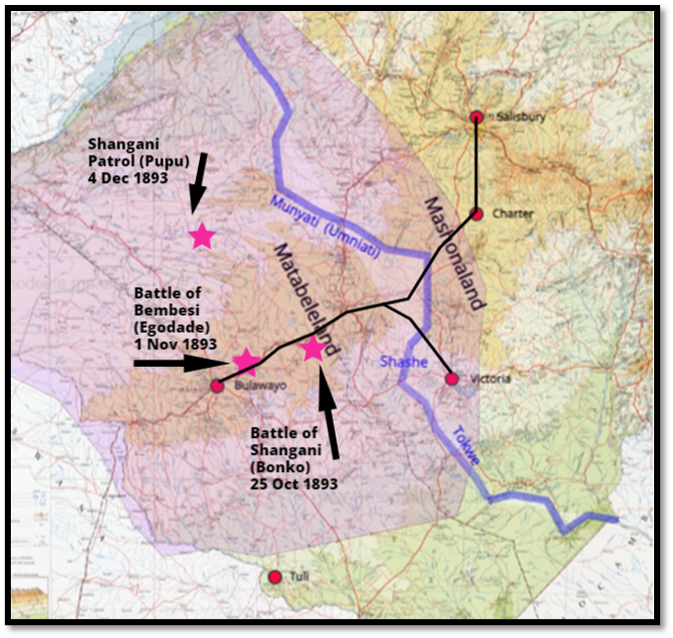
Map used with consent from Window on Rhodesia with the site name: https://www.rhodesia.me.uk Adapted from Stafford Glass – the amaNdebele border or boundary (both terms are used) as understood by Jameson along the Munyati (Umniati) a line south to the Shashe river, then along the Tokwe. Their raiding area after 1891 indicated by the pink coloured area
By 3 pm the drifts across the Shangani River had been made and two troops of mounted men were sent together with two Maxim guns and a seven-pounder to the small kopje south west of the crossing point and next to the national road to cover the river crossing. Two other mounted troops crossed the river; B Troop under Captain Borrow to the line of small hills on the northern horizon one and a half kilometres away;1 Troop under Captain Fitzgerald to the south of today’s A5 along a small tributary of the Shangani River to prevent any attack from this side during the river crossing.
Both the Salisbury and Victoria Columns each had eighteen wagons and they both hurried to cross the two drifts; all realised the river crossing made them particularly vulnerable to attack. The more northerly Salisbury Column got across their drift onto the west bank of the Shangani River in just sixteen minutes; the Victoria Column took nineteen minutes to cross. The two Columns then combined as one to save time cutting separate tracks and to reach the best possible laager site before nightfall. Both Forbes and Wilson would have preferred to have moved on further than the 1,000 yards (914 metres) from the Shangani River, but by 4:30 pm they needed to form the laagers and build kraals for the cattle before nightfall.
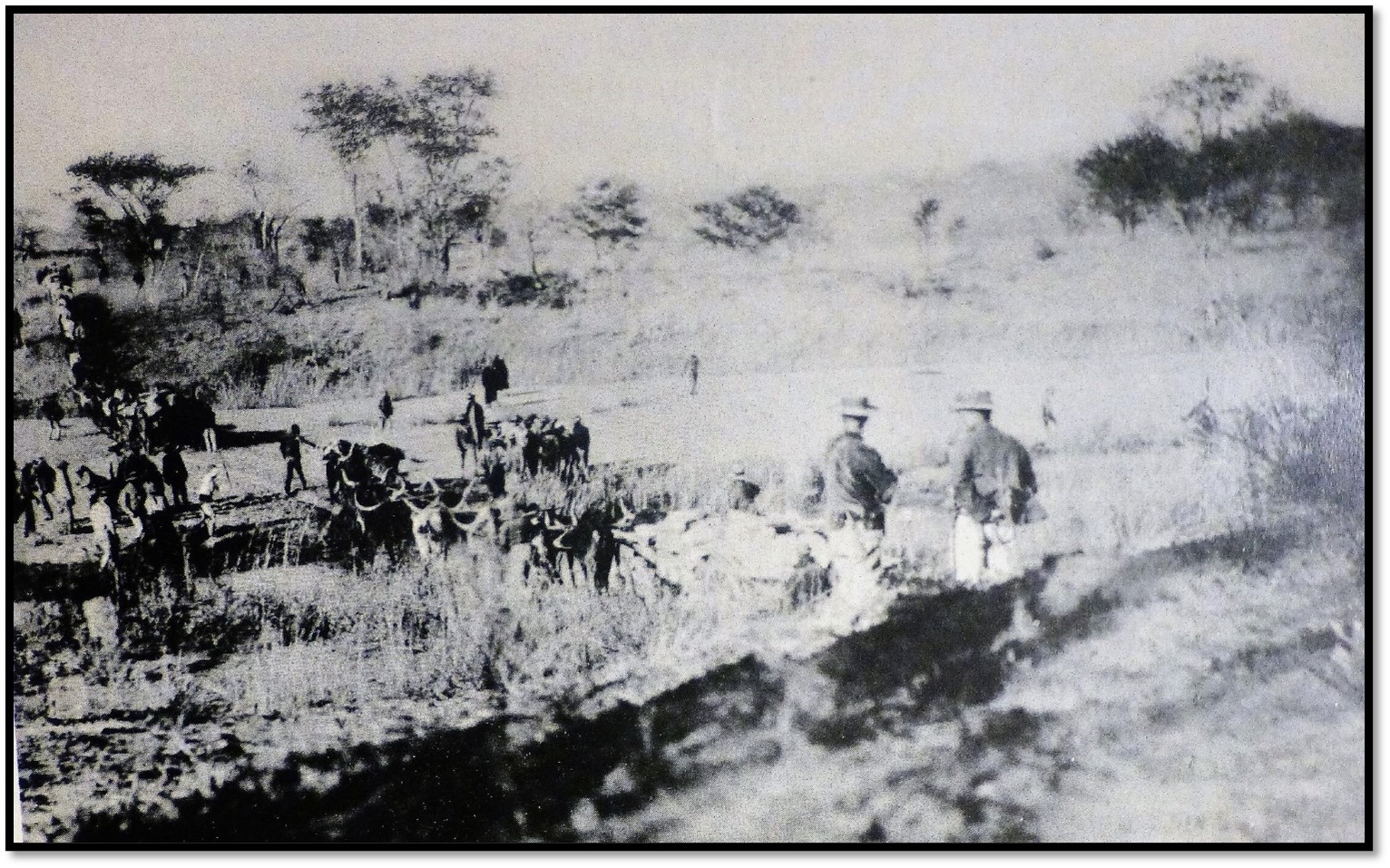
NAZ: The Salisbury Column crossing the Shangani river on 24 October 1893
The Columns had captured about 1,000 cattle and 900 sheep and goats and released many captive Shona as they made their way towards Bulawayo, so that their native contingent had gradually risen to about 1,055. Little grain for the animals had been found and there was not much time to build a cattle kraal before dark; but a makeshift one was sited 200 yards east of the wagon laager. The Shona built a makeshift kraal for themselves about 600 yards (550 metres) north east of the laager site; others slept in the open in the vicinity of the laager.
North
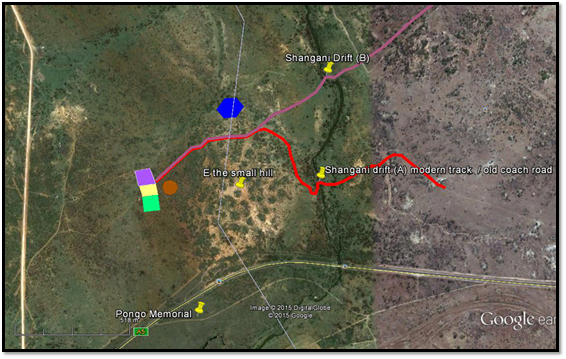 West East
West East
Shangani Battle on Google Earth. Purple = Salisbury laager, yellow = trek oxen, Green = Victoria laager, Brown = captured cattle laager, Blue = Quested’s Shona kraal
The site of the battlefield
The Google Earth snapshot above shows the main features of the battlefield. The Shangani River flows from south to North on the east side of the snapshot; the combined Column laager site is indicated by Purple = Salisbury laager in the north, yellow = the thorn bush kraal for the trek oxen, green = Victoria laager in the south, brown = the kraal for the captured cattle. The blue polygon north of the small hill = Quested’s Shona kraal about 600 yards (550 metres) north east of the laager.
The positions indicated are speculative, as no permanent signs of the laager were left; but are based on Major Forbes stating they were about 350 yards (320 metres) from the small hill - the highest point between the laager and the Shangani River - this the Columns had skirted around on its northern flank.
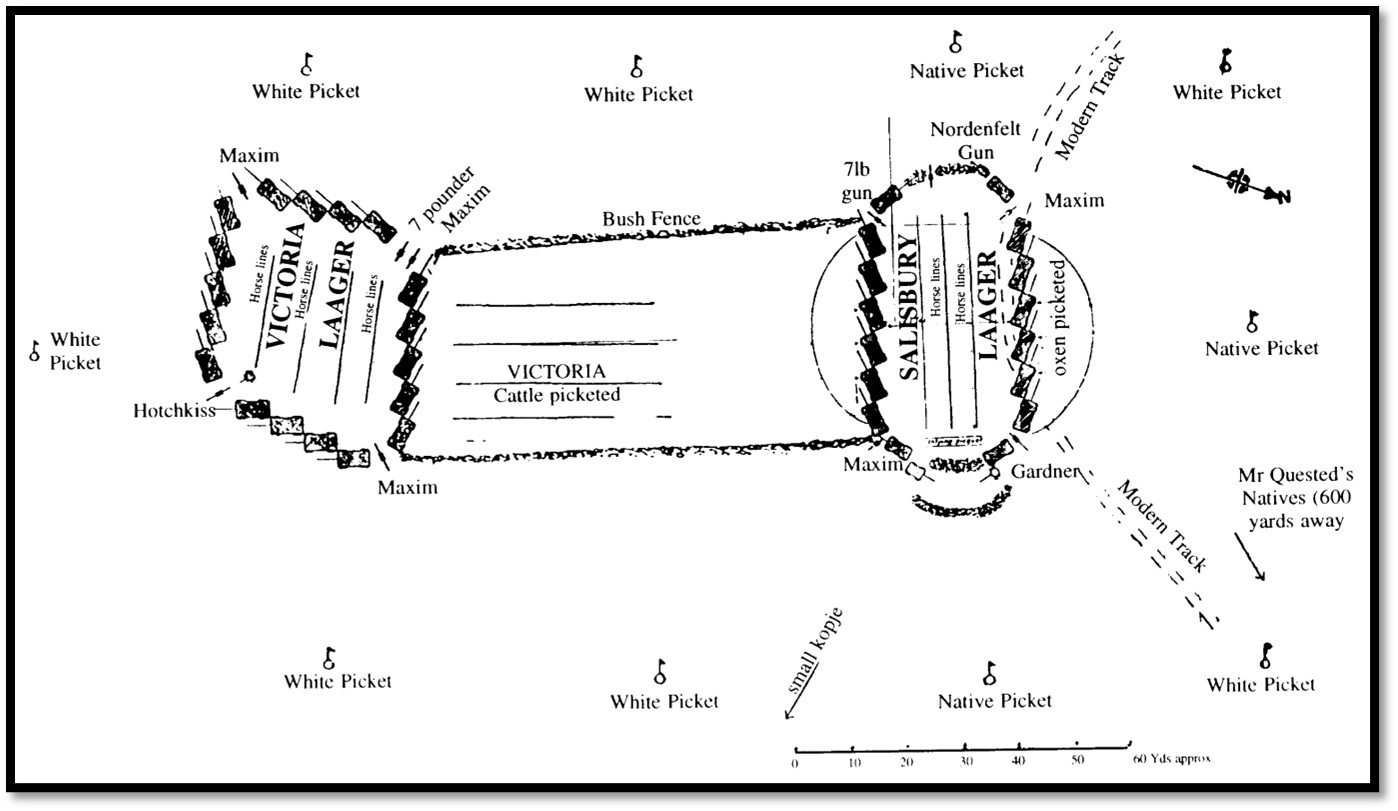
Diagram from I.M. Tomes article adapted from W.A. Wills and L.T. Collingridge. The laagers on 24/25 October 1893
The above diagram shows the layout of the combined laagers on the night of 24th October 1893. This was the first time the two laagers had connected with the bush fences that enclosed the Victoria trek oxen, the Salisbury trek oxen were in their usual positions outside the face of their laager. Note the diamond-shaped laager of the Victoria Column and the rectangular-shaped laager of the Salisbury Column. All the wagon covers were also removed to give clearer fields of fire and the bush for 100 yards was cleared away. The mounted troops were inside their respective laagers, the dismounted and artillery men formed the outlying pickets on guard duty about 100 yards from the outer edge of the laager. That night there were ten groups of pickets: eight of white Troopers comprising an NCO and six Troopers and two of Shona, comprising an NCO and three guards.
The mounted patrols sent out earlier under Captains Borrow and Fitzgerald came in shortly before nightfall reporting no AmaNdebele had been sighted (the impis were, in fact, on the eastern side of the Shangani river) and 30 Maholi (Shona slaves) were brought in by Fitzgerald’s patrol. These were related to Mr Quested’s native contingent and there was much rejoicing amongst them until late. Shortly after dark Forbes sent up signal rockets on the chance that some of the scouts from the Southern Column were in the neighbourhood.
The AmaNdebele had followed the Column from the Somabhula Forest in the east and soon after dark crossed the Shangani River and began to surround the laager and Quested’s Shona kraal. Their original plan had been to attack about 10:30 pm, but the noisy rejoicing amongst the Shona and then the sight of the signal rockets which the AmaNdebele had never encountered before, resulted in the attack being postponed.
The battle begins before dawn on 25 October 1893
At 4 am the laager would customarily wake for the “stand-to” in the pre-dawn darkness, but by that time on the 25 October almost 4,000 AmaNdebele were positioned around the site. Sir John Willoughby’s map shows how close they had moved to the laager without detection. At 5 minutes to 4 am everyone was alerted by firing to the north east of the laager and they realised the amaNdebele attack had begun.
Some Shona from Quested’s camp were walking down to the Shangani river for water about 3:45 am and walked straight into warriors of the Isiziba Regiment. Two Shona were quickly killed, but the third managed to get away and ran back to the native laager raising the alarm. The amaNdebele immediately attacked Quested’s kraal and began to kill men, women and children there. Mr Quested, sleeping at the native laager, received the first attack, getting up to find the amaNdebele upon them and stabbing whoever they can find.
Jack Carruthers wrote, “(We) were endeavouring to get the loyal natives to come into the laager, but they were confused, running in all directions. Most of the women ran to the veld, only to be killed by the oncoming Matabele.”
Burnham, “over and above all, the din of the firing rose the shrieks and yells of the friendly natives as they were stabbed and slaughtered by the onrushing Matabele. It was on this occasion that some of the unfortunate friendlies got mixed up with the enemy and were swept up against our laager, willy-nilly, to be shot down by our own Maxim guns.”[i]
Sgt-Major Judge, “… the Matabele got in amongst them and must have killed 50 or 60 and we must have shot about 10 or so in mistake.”
Forbes account of the battle – the first attack
The following is from Major Forbes account of the battle in the book The Downfall of Lobengula by W.A. Wills and L.T. Collingridge, At five minutes to four the following morning we were suddenly awakened by quick firing and realised the enemy were on us. The wagons were manned immediately, and fire opened all around the laager. It was too dark to see the natives at first, but their position was shown by the flashes that came from the grass all around the laager. [The AmaNdebele were equipped with a mixture of Martini-Henry rifles supplied by Rhodes for the Rudd Concession and assorted muskets bought in Kimberley and from Portuguese traders] I jumped up onto the nearest wagon and tried to see into the darkness, but could distinguish nothing but the flashes, which were very close and frequent. The enemy were so close to us that I did not think it safe to stop firing, even if I had been able to do so in the noise that was going on and I was very much afraid that some of the men on picket would be killed either by friends or enemies and I was greatly relieved to hear shortly afterwards that they all got safely in. During the attack Quested (in charge of the native contingent) came into the laager. He had been sleeping with his natives and they had received the brunt of the attack, waking up to find the AmaNdebele right upon them and stabbing them. Quested managed to make a stand for a short time and then retired on the laager with his people; he was wounded in the arm and side and had his thumb shot off. Most of his people managed to get inside the laager, although several were wounded. C Troop was inlying picket and had saddled up their horses at the first alarm. A Troop was on the right and B on the left of the laager. The first attack lasted about half-an-hour and then the enemy’s fire ceased; it was still too dark to see any distance, but objects in the immediate vicinity were visible.
As I was afraid that some of our friendly natives might have failed to get into the laager, I sent Captain Spreckley with twenty mounted men to go round the open ground close to the laager and see if he could find anyone; he brought in several of our natives and a few shots were fired at his party from the bush, but no harm was done.
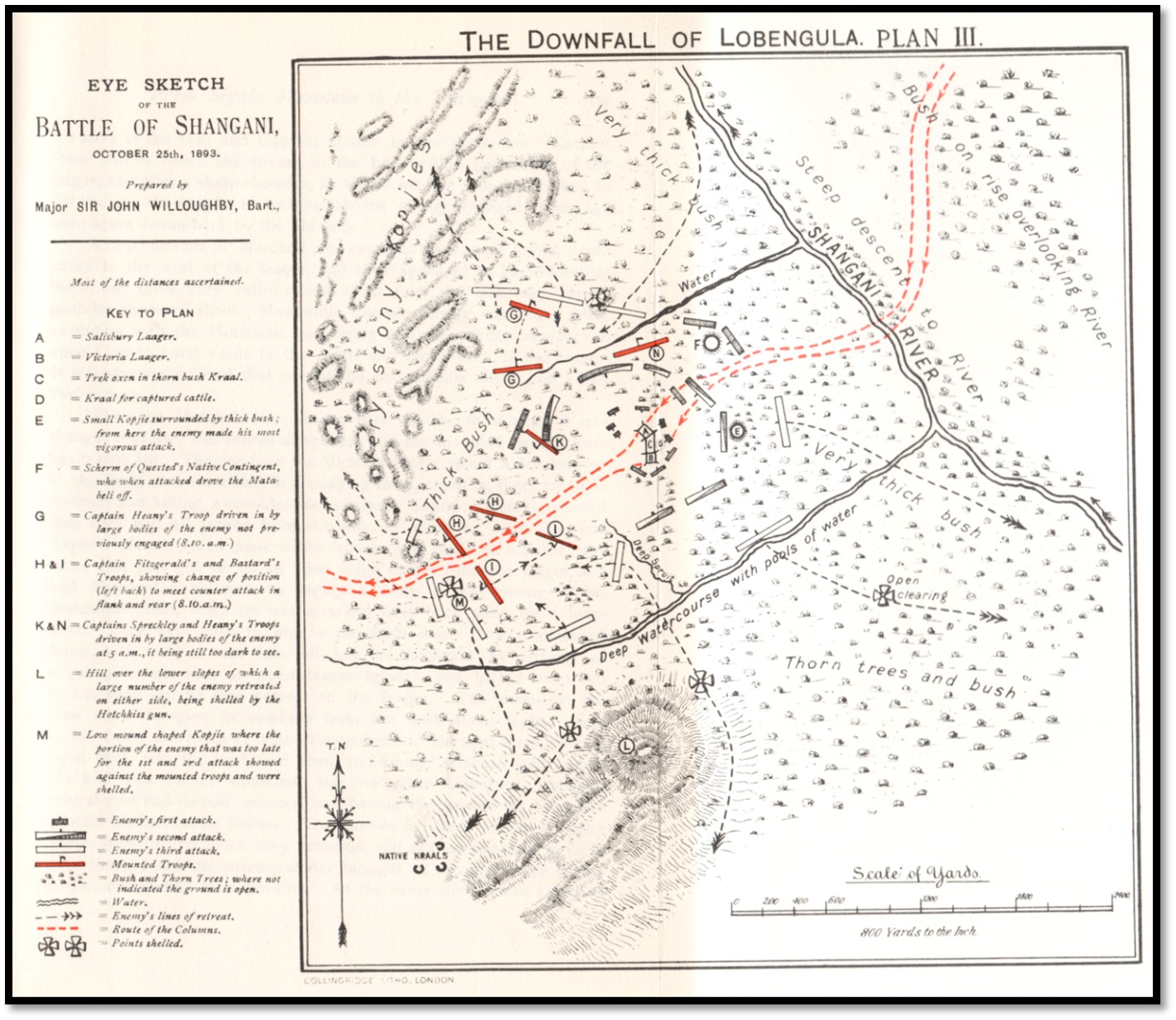
Sketch of the Battle of Shangani drawn by Sir John Willoughby from The Downfall of Lobengula Plan III
It appears that the first attack that started just before 4 am with the amaNdebele firing from the bushes which had been cleared up to about 100 yards from the laager, but not attempting to rush in and stab those at the wagons with their assegais and lasted about 30 minutes before the firing gradually died away.
After waiting for some time, during which only a few shots were fired at us at long distances and it was now broad daylight, patrols were sent out to see if the enemy had retired. [Captains Heany and Spreckley with 20 mounted men each were sent out to the north west and north east to see if the amaNdebele had left. Major Wilson sent the same numbers under Captains Bastard and Fitzgerald to the south west] Each of these parties found the enemy in the bush within half-a-mile of the laager and after a sharp skirmish, in which we lost four horses, had to fall back to the laager towards which the enemy followed them, but were driven back by the Maxims.
The second attack
Forbes continues, Shortly after they returned and when it was getting light enough to see some distance, a large number of natives were seen collecting on the top of a small rise about 350 yards [320 metres] to the south-east of the laager. [the small hill] I was standing with Mr Chappé at the Maxim at the left rear of our laager watching them through glasses and from the quiet way they were moving about, took them to be some of our natives who had escaped into the bush at the first alarm and now gone there for safety. There must have been between 200 – 300 of them and I could see no shields among them. After they had collected on top of the rise, they opened out and began to walk quietly towards the laager; I and I think everyone who was watching them except Mr Chappé, who insisted they were AmaNdebele, thought they were friendlies. They advanced down the slope in a most casual way, without hurrying or attempting to take cover and I allowed no firing on them. When they got to the bottom of the slope, they suddenly sat down and commenced to fire at us. A very heavy fire was at once poured on them from two or three Maxims and about 200 rifles and they were forced to retire over the hill much faster than they had come down. The way they advanced was most plucky and we found out afterwards they were the Insukameni, the best regiment there. Had the whole of the attacking force come on in the same way, we should have had more trouble than we had. As soon as they advanced, firing recommenced from the bush all round; but very few natives appeared in the open and after they retired, the firing ceased again.
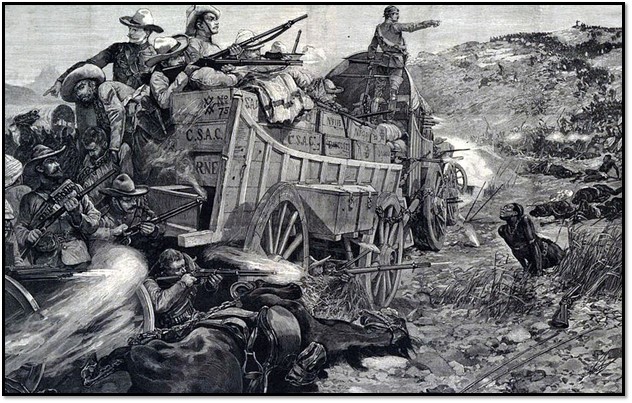
The battle of Shangani by the artist Richard Caton-Woodville
The third attack
This was more reaction to the Column’s mounted patrols than attack. Forbes again. A large number of amaNdebele now appeared on a small kopje, [Tisikiso] 2,000 yards to the west of the laager and they appeared to be reforming there, but three well-directed shells from the Salisbury seven-pounder dispersed them. Meanwhile Captain Lendy was doing great execution with the Hotchkiss gun, firing at small parties crossing the open 1,500 – 2,000 yards to the south and south-west of the laager. It was afterwards found that one of the one-pounder shells had killed twelve men.
About 8 am mounted patrols were then sent out and all encountered the AmaNdebele with Captain Heany being attacked so heavily A Troop had to retire to a better position at the gallop before opening fire on them and driving them back into the bush. He had two horses wounded, but no other casualties although there were some close escapes, one trooper having the sole of his boot and another had his belt cut by bullets. These attackers went behind a bushy kopje and Forbes had the seven-pounder moved to the north face of the laager and from there shelled their position. Captains Heany and Borrow with A and B Troop’s mounted men went to the east of this kopje but found the amaNdebele had retreated. Scattered amaNdebele warriors were seen in the hills to the north east and Capt Nesbitt took the friendly natives to drive them away, the ground being too rough for horsemen, but those individuals quickly disappeared.
Jack Carruthers wrote, we scouts were away early after the battle and I climbed a big hill [Tisikiso] south of the battlefield. Here I had a wonderful view of the retreating Matabele. There were several different impis moving in different directions, their shields and assegais glinting in the morning sun. A picture I shall never forget.
The battle is over by 8:30 am
Although the amaNdebele have left the battlefield they do so in good order rather than chaotic defeat and are ready for the next engagement. Major Forbes continues ‘we ascertained from a wounded native who was brought in that the force which attacked us consisted of the Insukameni, Ihlati, Amaveni and Siseba Regiments and Jingen, Enxna, Zinyangene and Induba kraals, in all not less than 5,000; that they had been waiting for us in the Somabhula Forest, but that we had passed it before they knew where we were and that they had then followed us up, expecting to catch us before we got to the Shangani River; that they had arrived shortly before dark the previous evening and had been in position to attack about 10 pm, but the rocket signals sent up had frightened them and the attack had been postponed until daybreak. They were all to advance as close to the laager as possible under the cover of darkness and then rush in with assegais. It was finding Quested’s natives so far away that caused the first firing and so gave us the alarm.
Bishop Knight-Bruce's version
He writes, at about 4 o'clock I was woke by the first shots and shouts, ‘here they come.’ I jumped out of my wagon as the first shots came past. When the Matabele were first seen, some were only sixty yards from the wagons and their fire seemed to come from all directions… I was met by a wounded man… how he got in with the Matabele behind him and the machine guns in front is a mystery.
Jack Carruthers' version
The following notes provide a different perspective from that of Major Forbes and are from the note books of Jack Carruthers, a Victoria Scout present at both the Shangani and Bembezi battles.[iii]
October the 24th around 4 pm we rode back as the column was preparing a drift. They had called a halt at the river. Captain Charles Lendy, a keen artilleryman, was trying out a Maxim gun. Knowing our combined columns were being shadowed, preparations for safety were promptly made. We laagered just before dark.
The laager was formed into a large square with the wagons about 600 yards up from the river, on an elevated ridge overlooking the valley to the south. The Black Watch, as our native followers levies were called, had cleared our front, by cutting down all the trees on the south and west side of the laager for some distance. These were used for brushing in the openings, between the wagons. The picketing ropes for the horses were fixed in the centre. The oxen lay on their yokes with chains turned inwards and the men were told-off to certain wagons in case of alarm. Quested, with his native rear guard, took up a position at our rear on a small kopje. At dark Brabant and Nobby Clarke, with my brother, brought in a number of Mashona women known to some of our natives, along with captured loot. They were placed between the laager and a timber ridge on the north east side. They had schermed themselves in for the night. Dollar, with the scouts, slept out near the timber, about one hundred yards east of the wagons. I slept in laager and occupied the top of Bradfield's wagon with Jim Stoddart and Harry Cumming, my friend Alfred Webb taking up a position underneath. Both Parkin and Lynch of my trek party were out on guard. Two rockets were put up about 10 pm without any purpose and only disclosed our whereabouts.
It was just about 2:15 am, [note most accounts state almost 4 am] with a clear sky but on the dark side, when the bugles gave the alarm. The camp was all excitement in a moment. The moving camp was all noise with the opening of ammunition boxes, the shouting of officers and the men getting into their places. The din outside the laager from the on-rushing Matabele could be distinctly heard. Quested was the first attacked, and only got into laager in the nick of time. It was three of his boys who had appraised us of the situation by going down to fetch water at the drift and walking into the Matabele impi which was there planning the attack on the laager. Only one of these boys got back and he was badly stabbed. Brabant and my brother were endeavouring to get the loyal natives to come into laager, but they were confused, running in all directions. Most of the women ran into the veld, only to be killed by the oncoming Matabele. Our Maxim gun was forced to open fire as the ridge to our east was a black mass of the enemy, their Indunas trying to persuade them to charge our laager. Our scouts had no time to loosen their horses of which several were assegai’d. Texas Long was the only one to bring in his old charger and Dollar lost his mount. The outer sentries had a narrow escape getting back into laager. I called Webb up into the wagon at the onset, and strange to say, our small bushman boy was found dead, shot in the place which Webb had just vacated.
Salisbury laager lost one man, Harry Watson, killed and several wounded. The Matabele retreated at daylight. Several had hung themselves to trees with their girdles rather than return beaten and one had killed himself by falling on his own assegai. We had unfortunately killed about 40 of our loyal natives, having had to open fire with the Maxim gun.
We scouts were away early. I climbed a big hill two miles south of the Shangani Battlefield. [Tisikiso] where I had a magnificent panoramic view of the retreating AmaNdebele. There were several impis moving in different directions, their shields and assegais glinting in the morning sun - a picture I shall never forget. In the afternoon, after shelling the natives out of the hills, the Columns moved on for safety to an open plain, (now Shangani siding) where we prepared for trouble.
Trooper George Rattray’s version
Another account quoted by R.C. Knight is given by George Rattray in a letter written soon after the Battle of Shangani to his mother:
Buluwayo
Matabeleland
Nov. 11th, 1893
My dear Mamma
I take this opportunity to write to you as a carrier goes to Tati tomorrow. I would have written before but have had no chance whatever. We crossed the Shashi on the 15th October and have had a fairly lively time ever since. The Salisbury column joined us about six days after and we have laagered side by side ever since. The day before we met our scouts had the first skirmish and captured 600 head of cattle, the Salisbury scouts capturing 250. 250 of the best were picked out and sent back to Victoria as loot, the remainder we ate in a couple of weeks. Captain Campbell of Salisbury had his leg shattered by a lump of iron the beggars load their guns with, and had to have the limb cut off, he died the same night and was buried with military honours. We had two or three brushes with them later on and shot a good many but nothing serious occurred till we got to the Umshangaan River. We had to outspan in a bad spot as the oxen were knocked up having to trek a long way for water. There was a good bit of bush about and a rise or small Kopje about 400 yards on our flank. About 4 o'clock in the morning the outlying pickets commenced firing. The alarm was sounded, and every man was at his post on the wagons. In the excitement our pickets were mistaken in the dark and had a regular volley of bullets sent into them from both laagers, but fortunately none were hit. The Maxims were turned on a lot of our Mahalakas, the useless brutes coming rushing towards the laager with assegais and guns and consequently being mistaken for AmaNdebele. Seven or eight were killed and a numerous lot were wounded. When they were shot they had the sense to lie still till the fight was over. The AmaNdebele got on the Kopje and commenced a galling fire on us as they got behind anthills and stones. There were two regiments we afterwards found out about 5,000 men. As soon as it commenced to get light we could see them and then they got it, directly one showed himself about twenty bullets were after him and one always told.
As soon as the sun got up we were ordered to mount and clear them from the valley and flats. As soon as they were seen from the laager trying to surround us, the Maxims and shell guns opened on them. We soon cleared them out though I can tell you the bullets were coming thick. Reins were cut, shoulder straps taken away, hats bored, horses shot underneath their riders yet strange to say not a man was wounded. The one pounder killed twelve in a lump not far from us and the seven pounder shelled the Kopjes all round within 4 miles. The latter gun did tremendous damage, killing them by fifties. They couldn't make it out at first as they saw the smoke miles off and heard the report and presently another report in the middle of them and dead and dying all round. They call it the "bye 'n bye" gun and at first it was amusing to see them fire volley after volley at the shell directly it dropped, thinking if they hit it they might kill it. We moved from that place the same afternoon and laagered two miles further on in a good position.
The letter then goes on to describe the Battle of Bembesi.
The amaNdebele regiments involved
Those regiments actively involved in the battle included the Insukameni, Isiziba, Ihlati and Induba and in reserve the Amaveni, Umjinge and Enxna regiments. It has been estimated that by the time the AmaNdebele withdrew, they had suffered around 500 fatalities, most were taken away along with the wounded. The plan, now the opportunities to ambush in the Somabula Forest and when the Columns were crossing the Shangani river had been missed, was to attack about 10:30 pm on the 24 October when the moon was brightest, but the signal rockets and noisy celebrations of Mr Quested’s Shona resulted in this plan being postponed until the pre-dawn darkness next morning. Although various accounts put the number of warriors involved at 5,000; Tomes estimates that probably about 3,800 were actually involved in the fighting, the remainder held in reserve.
The Column’s casualties
Trooper Walters of the Victoria Column was wounded and died the same night and six others were wounded including Trooper Forbes, the Major’s brother. A Shona wagon driver and around 40 – 50 friendlies were killed, including women and children, mainly from the initial attack. Lobengula's warriors were well-drilled and formidable; but the firepower of the Column’s Maxim guns, which had never before been used in battle, far exceeded expectations. Major Forbes attributes the low Column casualties to the belief by the AmaNdebele that the higher they put up the sights of their rifles, the harder they would shoot and consequently nearly all their shots were too high. Forbes also says, we had noticed a curious thing that morning, that whenever a shell exploded all the Matabele nearby fired their rifles at it; on enquiry from a prisoner we found that they thought that the shell was full of little white men, who ran out as soon as it burst and killed everybody nearby; we saw this done almost every time a shell was fired during the campaign.
Bishop Knight-Bruce took charge in bringing all their wounded to the laager where they had their wounds dressed and were afterwards moved on a wagon. Forbes writes that the trek oxen showed little alarm at all the shooting. When the attack began they all stood up from their trek-tows on the outside of the wagons, but then did not move, standing perfectly quietly despite the heavy firing and several being killed.
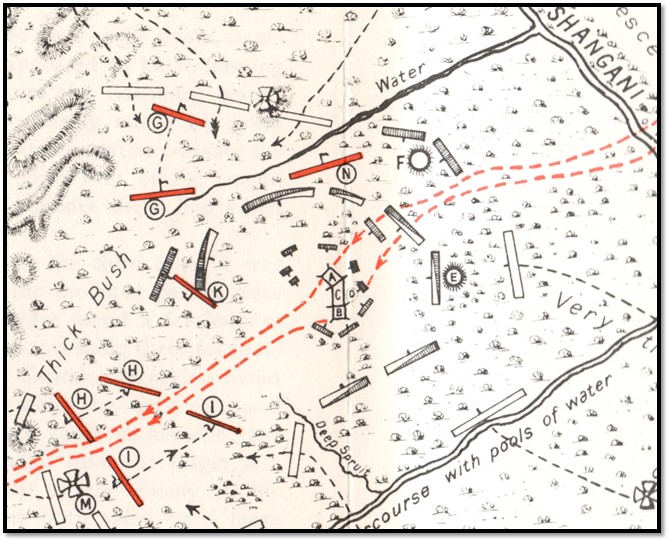
Adapted from Sir John Willoughby’s Plan III in The Downfall of Lobengula
KEY
A Salisbury laager
B Victoria laager
C Trek oxen enclosed in thorn scherm
D Captured cattle kraal
E the 'little hill' 350 yards from the laager
F Quested’s native contingent kraal
G Captain Heany driven in by amaNdebele at 8:10 am
H&I Captains Fitzgerald and Bastard Troops driven in by amaNdebele at 8:10 am
K&N Captains Spreckley and Heany Troops driven in by amaNdebele at 5 am in the dark
M Low kopje where amaNdebele were shelled
Ammunition usage
The number of rounds used was amazingly low. Forbes states, M.H. including Maxim and Nordenfelt gun, 3,645: seven pounder case 2, shrapnel 1, common 4: Hotchkiss 28: Gardner 400. All the machine guns worked very well indeed and without a single jam of any importance.
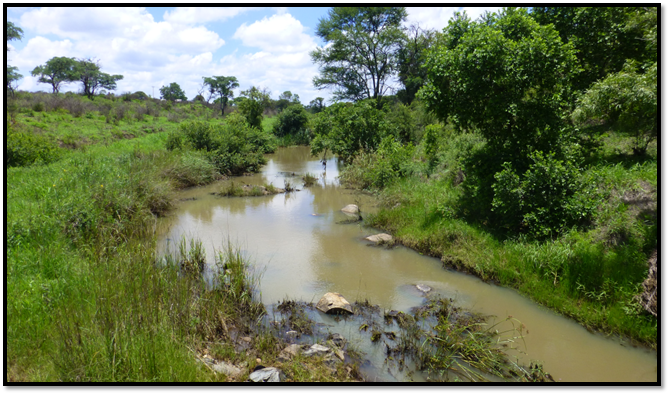
Shangani river in Jan 2015, the eastern bank on the left is a gentle slope, the western bank much more steep. The 24 October 1893 photo above is from the eastern bank looking to the west bank
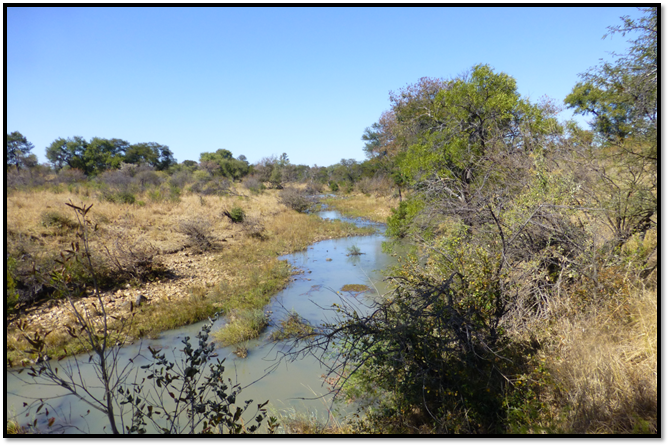
Shangani river in June 2015. The same gentle approach on the east bank, very steep on the west bank

The Shangani drift (B) where I believe the Columns built parallel drifts within a few metres of each other – Major Willoughby’s map does not show much space between the drifts. Note where the banks have been cut for the drift between two overhanging trees.
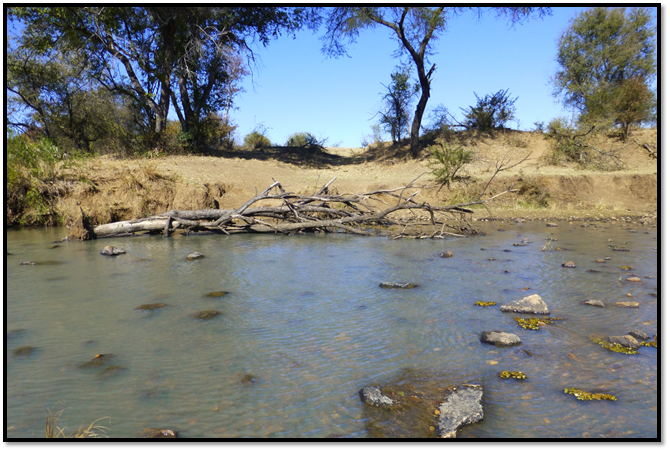
The Shangani River at drift (B) note how shallow the river is at this point
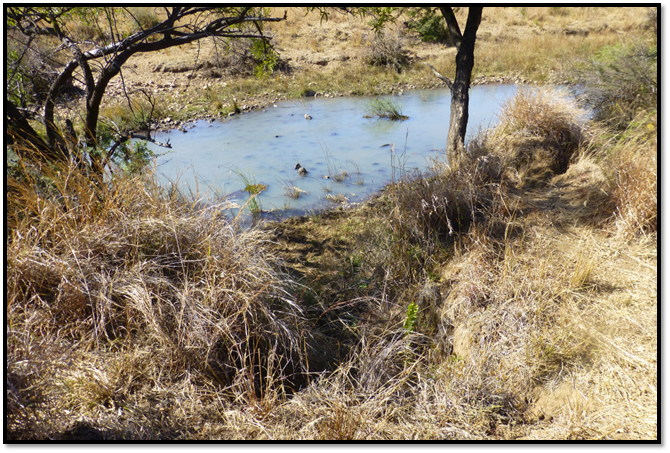
Shangani river at drift (B) where the western bank needed to be dug out for an incline to enable the ox-wagons to get up
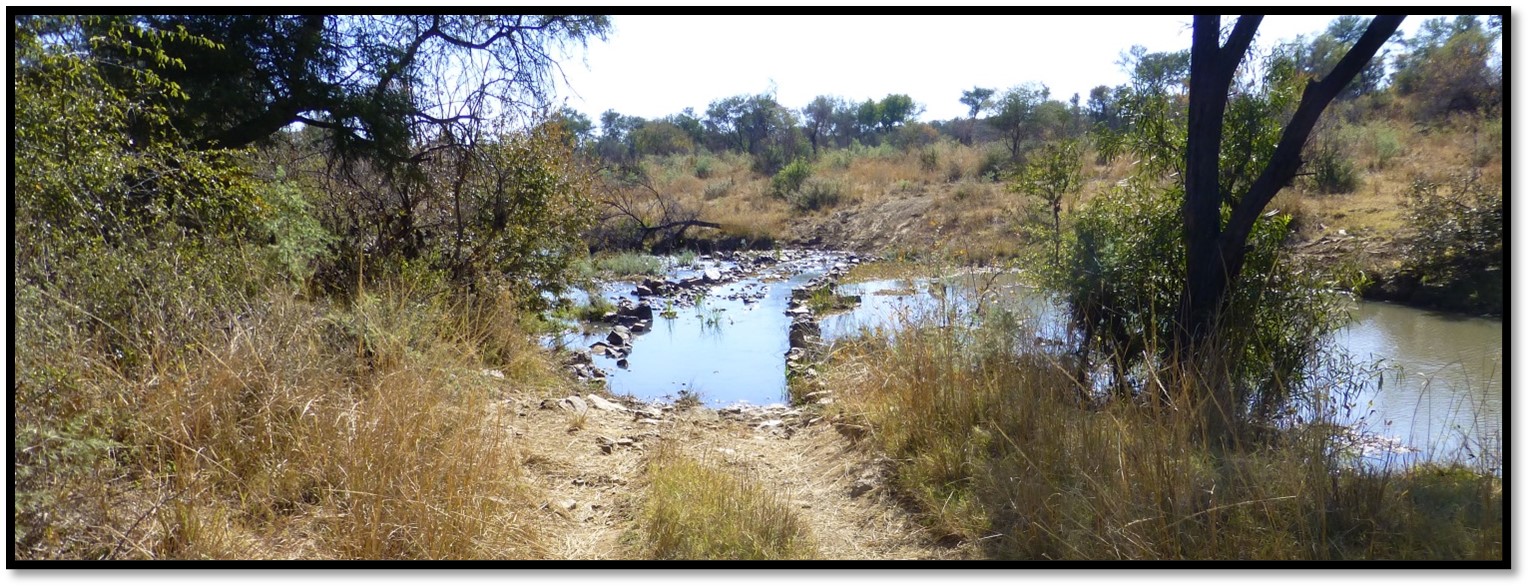
The Shangani drift (A) much further south and still used today and by the Zeederberg coaches in 1896 with stones indicating the route

Different views of possible wheel ruts from the ox-wagons of the Salisbury Column before they joined with the Victoria Column
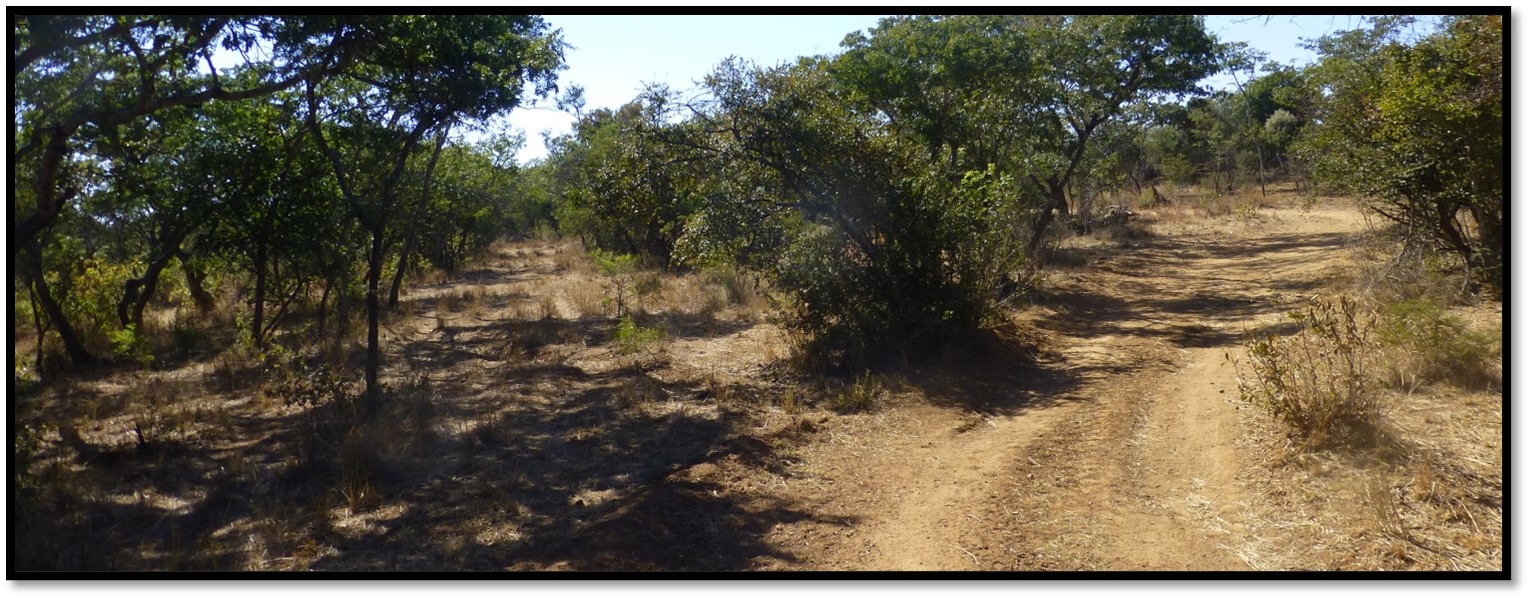
The Salisbury and Victoria Columns were joined into one Column (the modern-day road on the right follows the old coach road around the small hill) before they laagered some 300 metres west of this point

The likely spot of the Laager and battlefield site looking northwest to the stony kopjes of Willoughby’s diagram. The fact that although over 3,600 rounds were fired and there are none to be found on the battlefield is easily explained – cartridge cases were valued for carrying snuff and often melted in African iron-furnaces for making brass bangles.

Wide-angle photo showing Tisikiso Hill on the left horizon and the range of hills on the right horizon that the Columns passed through in the afternoon of 25 October to that night’s laager on the site of present-day Shangani siding
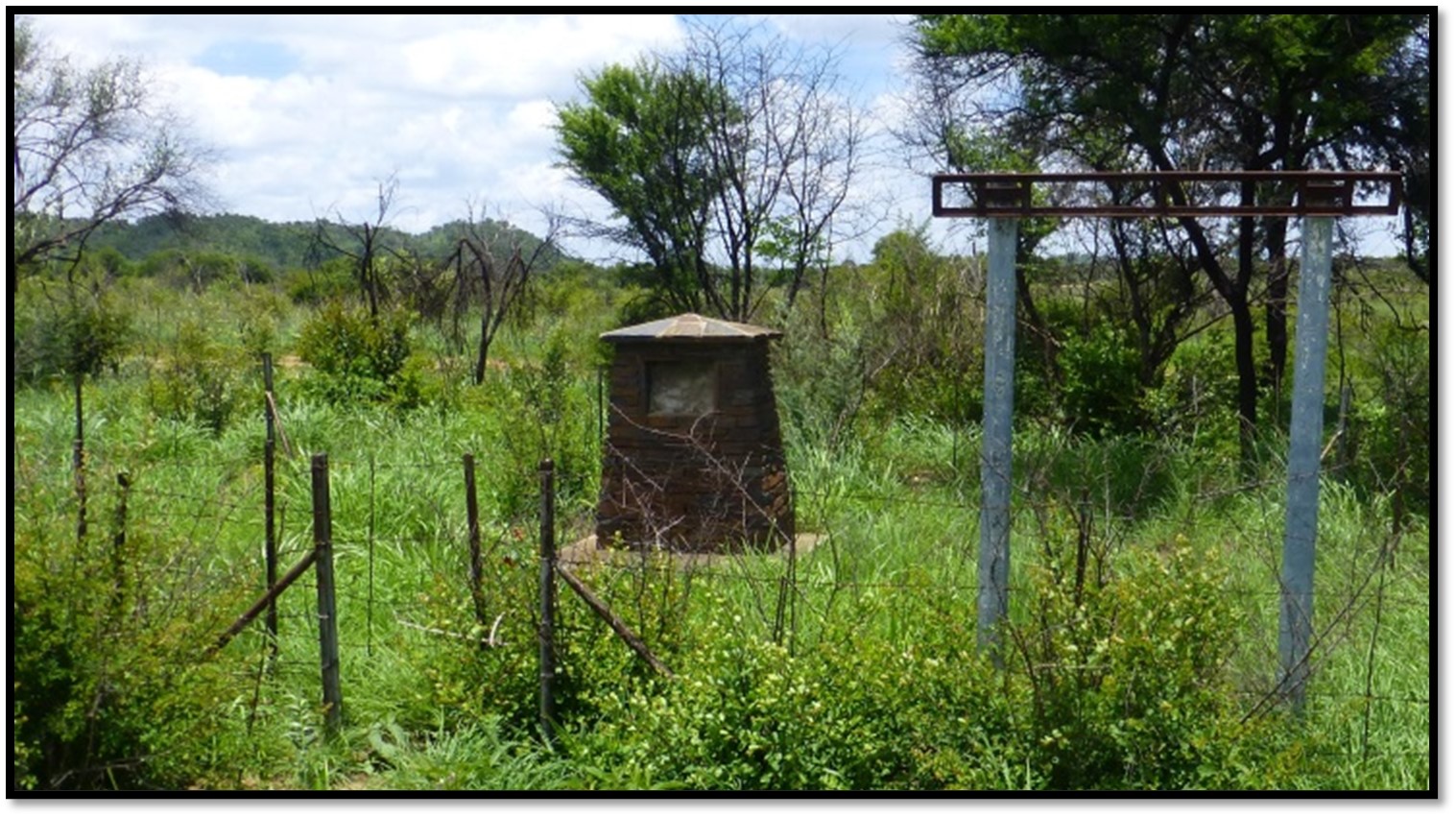
The battlefield cairn and signboard on the A5; both damaged to conceal their purpose
The combined Columns move on from the Shangani battlefield
As soon as it was obvious the amaNdebele had left the field, pickets were posted and the horses and oxen taken out to graze.
The Columns moved off in the afternoon about 3 pm trekking through a narrow pass in a range of hills to the west of the laager site – Forbes writes it was the most anxious time he had through all the campaign as the wagons were overlooked from the hills and the Columns very close to each other. After 3 miles (5 km) they emerged from the hills into a large open valley and laagered, probably north of present-day Shangani.[iv] The laager was made very strong with thorn bushes, but there was no attack and Trooper Walters of the Victoria Column who had died of his wounds was buried here.
Major Tomes reconstruction of the Shangani battle
Major I.M. Tomes in an excellent article on the Matabele War favours the Shangani Drift marked (A) on the Google view; whereas I favour the more northern drift marked (B) When you walk the battle site, the small hill marked on Willoughby’s map is actually bigger than first indicated as shown by the modern farm track / 1896 coach road which has to follow the contour of the hill and is indicated on the Google view. The route indicated on Willoughby’s map is generally south west as indicated by the purple route from drift B and does not show the curve around the hill following the contour line. The second argument in favour of drift (B) is that it is much wider than drift (A) which as the photo shows is narrow and has to be indicated with upright stones. The two Columns crossed on separate drifts which drift (A) would not permit. Drift (B) is quite shallow, especially in late October ,when the water level of the Shangani river would be low and would permit two drifts even though they may be close. Although Major Forbes knew the Columns were vulnerable crossing the drifts, he mitigated the risk by sending two mounted Troops with two Maxims and a seven-pounder gun onto the small hill. Two more troops were sent: one under Capt. Borrow to the north and the other under Capt. Fitzgerald to the southwest. Their tasks, to destroy kraals, seize cattle and prevent us (i.e. the Columns) being attacked while crossing.
Reinforcing the theory of drift B is Jack Carruthers’ statement, “It was three of his boys who had appraised us of the situation by going down to fetch water at the drift and walking into the Matabele impi”…from the map it ca be seen that Quested’s native contingent were north east of the Column’s laager site.
Stafford Glass estimates the amaNdebele forces at 5 – 6,000 warriors. Their leader Mjaan had left instructions they were to attack at 10 pm on the night of 24 October, but they were frightened by the sight of the signal rockets and postponed the attack until early next morning. Some accounts state that Manonda, the Insukameni regiment commander, committed suicide after the attack by hanging.
APPENDIX A: FROM MATABELELAND AND HOW WE GOT IT - MAJOR SIR JOHN WILLOUGHBY'S REPORT OF THE BATTLE OF SHANGANI FOUGHT ON 24 OCTOBER 1893, FORWARDED TO THE WAR OFFICE[v]
Bulawayo Nov. 24, 1894.
THE Salisbury and Victoria columns crossed the Shangani river without opposition by 3.50 p.m. on the 24th of October 1893 , the country to the front and on both flanks having been previously well reconnoitred to a distance of five or six miles without any signs of an enemy having been found, though rumours from our native contingent in the rear, and from natives found in kraals to our right front, led us to believe that a force of some seven regiments— which had missed the chance of attacking us at the edge of the Somabula forest, through having been drawn off by our night advance and the burning of the Insukameni kraal on October 21st -had now passed through the forest and bush some ten miles away on our right flank , and were now threatening our right front, in rear of the range of hills and broken country overlooking the left bank of the Changani river and running parallel to it at a distance of about a mile from it. Immediately after crossing the river the ground is much impeded with bush and large thorn trees, and intersected by many dongas (or dry sluits ) and water courses. The column advanced three-quarters of a mile beyond the river up a gradual slope where the bush was thinnest, covered by two Maxims placed on a low and partially wooded rise, situated a few hundred yards to the left of the line of advance, and laagered for the night in the most open space to be found between the two small tributaries of the Shangani river, and at a distance of about 1,000 yards from the nearest kopjes. Except for isolated patches of bush, the ground in the vicinity of the laagers was fairly open to a radius varying from 300 to 600 yards , the low-wooded rise, marked E on the plan, being some 500 yards distant.
N.B.-The above position was far from a good one, and much in favour of an attacking force. Had the columns advanced two miles further on, fine open ground could have been selected , beyond the range of broken country and the dense bush of the neighbourhood of the river; but, as events turned out , it was as well, perhaps, that this was not done, as it is quite possible that the enemy was induced to attack us, when he did on account of the apparent weakness of our position and might have been deterred from risking a decisive engagement had a better one been selected.
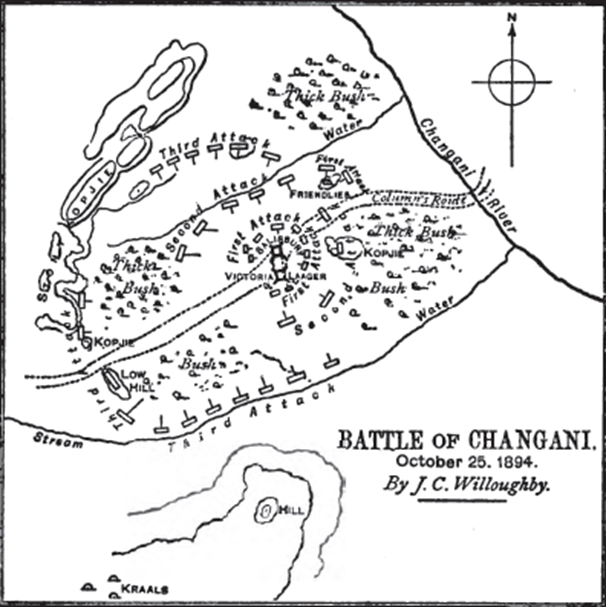
Map prepared by Major Sir John Willoughby
Precautions were taken in strengthening both laagers with thorn bushes at the weakest points, the general line of front and rear of both facing about the west and east respectively and running nearly parallel to the course of the river. The trek oxen, with the exception of those picketed on the right face of the Salisbury laager, and on the rear of the Victoria laager, were picketed in between the two laagers, a small thorn fence on either side of them partially enclosing them and connecting the two lagers. Immediately in the rear of them, and about 80 yards distant, a circular thorn scherm was made to hold most of the captured cattle, of which about 1,000 head had been taken by our patrols and reconnoitring parties during the course of the day. Six white pickets, each furnishing two sentries in three reliefs, and six native pickets, each furnishing one sentry in three reliefs, were posted round the camp at a distance of 150 to 250 yards from it. Quested's native contingent, 500 strong — which formed an extra rear guard, some three miles in the rear, during our daily treks — were encamped on a slight rise, 800 yards to the rear of the Salisbury laager between it and the river, and with it the remainder of the recently captured cattle. This camp was supposed to be guarded against surprise by a native picket, 50 strong.
The first notice of attack came from the direction of Quested's camp, where heavy firing commenced at 3.50 a.m. Soon afterwards the pickets ran in on all sides, and the ground on which the Victoria and Salisbury right front pickets had been posted was almost simultaneously occupied by the enemy, who opened at once a steady and continuous fire on all sides with Martini rifles and muzzle-loaders. In the meantime our men, generally speaking, behaved with great coolness and steadiness (especially considering that a large proportion had never previously been under fire) and had manned the wagons, returning the fire, from both laagers intermittently, whenever it was possible to distinguish by the faint light of a setting moon any bodies of the enemy.
A large number of Brabant's native contingent, who had been placed in the captured cattle scherm, got panic-stricken, and ran in on the Victoria laager right across the line of fire of the machine guns , and several were shot. This was unavoidable and could not have happened had they obeyed previous instructions and run in direct amongst the trek oxen between the laagers. A few of Quested's men also fled to the Salisbury laager, and a few in consequence were shot, but the majority of his contingent stood their ground well, and inflicted considerable loss on the enemy, although he got right amongst them, and assegai’d several, including many of the recaptured women and children. (These had been raided from the Victoria district by the Matabele this year and had only been recaptured by our patrols the day before the fight) They eventually retired slowly and in good order on the laagers after daylight had dawned; but not till their leader was severely wounded.
The enemy's first attack was chiefly directed against the right face and rear of the Salisbury laager and the left and rear faces of the Victoria laager; though Quested's contingent, from its position, decidedly broke the force of the attack on the Salisbury right and afforded most valuable assistance by giving us timely warning of the attack, and so ample time to prepare. It was afterwards ascertained from a wounded prisoner that the attack on the front of both laagers was considerably weakened by the regiment that was detailed to advance on that side from the south-west, not arriving in time to take part in the first attack. In several places the enemy advanced to within 150 yards, and a few to within 80 yards, right up to the captured cattle, which were then stampeded. About 300 massed within 150 yards of the Victoria left face, under cover of a clump of bush; some few individual parties of two or three approached to within 80 or 100 yards of the Salisbury front face, but the majority of the enemy never advanced beyond the edge of the surrounding bush at distances varying between 300 and 500 yards. The heavy firing continued for 20 minutes, when the fire of seven machine guns proved too hot, and drove the enemy on all sides further back into the bush, as they merely kept up a dropping fire till 4.30 am.
Captains Heany and Spreckley were sent out with their mounted troops from the Salisbury laager to clear the bush to the left front and right flank, but finding large bodies of the enemy, and there being still in sufficient light for them to act efficiently, they were almost immediately forced to retire, which was just as well, as they were only masking the fire of the laagers without doing any good. Both troops made two charges, but were each time driven back.
Firing then ceased till 5.30 when the enemy made a second advance, chiefly from the river side, on the Victoria left rear, a large body also collecting on the low rise marked E, lying in between those two points. The Maxims could here have done great execution , but then fire was withheld for fear that this body might be some of our friendlies, and this was not the only opportunity, which was unavoidably lost, when the enemy showed in compact bodies our fire being similarly withheld for the same reason. The second attack was far less determined, for by this time daylight had become well established, and thus a much more certain fire could be directed on each point, wherever the enemy attempted to show himself, and he again soon fell back, on all sides, lining the watercourses on our right and left, again concealing himself in the thickest bush, lying between us and the river. About this time the impi that had not arrived for the first attack came up, and began collecting on the rise marked M, 2,200 yards to the south-west of our position. One of the 7-pounders was advanced from the Salisbury laager, and brought to bear on this position, which at the second shell, well directed by Capt. Moberley, was evacuated; at the same time Captains Fitzgerald and Bastard were sent in that direction with their mounted troops. These swept the intervening ground in skirmishing order, driving the enemy well beyond the hill; upon which the enemy, lying hid in the watercourse, rushed out to our left to intercept and cut off their retreat. Major Wilson, seeing this, sounded the “retire" but our men, having also observed this counter movement, changed positions “left back" and with a few shots, drove the enemy back across the stream and soon after masses of them were to be seen in full retreat round the lower slopes to the east and west of the hill marked L.
The Hotchkiss gun here did good execution, inflicting considerable losses on the retreating enemy on these slopes and wherever they were seen crossing in numbers the open space in the bush below. In the meantime Capt. Heany went out from our right rear with his troops and found the bush and watercourse on that side quite clear of the enemy; but, on reaching a ridge running at right angles between the kopjes and the river, at a distance of about 1,200 yards he encountered the enemy's reserve, under the command of Malevu (the only mounted man present) which had not hitherto come into action and though his troop got within 30 yards of this force without perceiving them, experiencing also a heavy fire, its casualties were only two horses wounded. However a large mass of the enemy charged his troop, and Capt. Heany was forced to retreat, hotly pursued for some 200 yards. A Maxim and a 7-pounder were then advanced from the laager to cover his retreat and the result of one or two well-placed shells drove the enemy again back. The engagement was now (8.10 am) practically over.
At 8.30 am mounted troops were again sent out to patrol the vicinity of the camp and to drive off any remaining parties of the enemy, but a general retreat had been effected by them on all sides along the bank of the Shangani river and through the kopjes and broken country, so that by 9.30 am the country was reported clear all round for a distance of three miles.
Our total casualties were, in the Victoria column: killed, 1 colonial native, 12 Mashona contingent ; wounded, Europeans, I severely (died next morning) 3 slightly, 26 Mashona contingent. Salisbury column: killed 10 Mashona contingent; wounded Europeans 3 slightly, Mashona contingent, 5. Total: killed, I colonial native, 22 Mashona contingent; wounded, Europeans 7, Mashona contingent 31. Horses: killed 8; wounded 2.
It was afterwards ascertained from a wounded prisoner that the Insukameni (200 strong and one of the best regiments) the Ishlati, Isiziba and Amaveni regiments with the towns of Induba, Jingen, Inyangen and Enxna took part in the attack an with estimated total number from 5,000 to 6,000. Their instructions from Mjaan, the Matabele general, were to surround the laagers completely and to rush in with the assegai, without firing a shot and it was through one of the Amaveni letting off his rifle that this did not occur and no doubt, as before said, the position of Quested's kraal prevented them making a more sudden attack.
The enemy had intended to attack at 10 pm but postponed it until 3.30 am on account of the three rockets being sent up at 8 pm to acquaint a belated patrol with the whereabouts of our camp . Unondo, in command of the Insukameni regiment, was wounded, and afterwards found hanged to a tree by his own hand.
Owing to the broken nature of the ground and the fact that the enemy was seen carrying off large numbers of his dead, it is difficult to form an exact estimate of the losses of the enemy; but, from the number of bodies I myself counted, I should say that 200 to 300 killed would be a low estimate; and natives subsequently stated that 300 were killed, irrespective of the wounded, so that probably 500 to 600 killed and wounded is a fair estimate. The wounded prisoner states that the force was divided in opinions about attacking in this place, and this, no doubt, combined with the position of Quested's camp and the excellent working of all the machine guns and shell guns, probably prevented a more determined attack being made. It was unfortunate that our success could not be better followed up and the victory made more complete, but this was impossible, considering the broken nature of the ground, rendering it unrideable in most parts and because this and the thick bush afforded immediate cover to the enemy whenever he chose to retire.
The column broke laager at 3 pm and advanced some three miles to open ground.
References
Notes from Sergeant Jack Carruthers. Victoria Scout Shangani and M ‘Bembezi Fights. October - November 1893. Copyright © 2007 by Ian Carruthers.
P. Forbes (Chap VIII) and Sir John Willoughby (Chap XIV) in W.A. Wills and L.T. Collingridge. The Downfall of Lobengula. Books of Rhodesia Volume 17. 1971.
S. Glass. The Matabele War. Longmans, Green and Co Ltd, London 1968
N. Jones. Rhodesian Genesis. Bulawayo 1953
R.C. Knight. Letter from George Rattray. The Journal of the Rhodesian Study Circle. 1987
R.L. Moffat. A further note on the Battle of Shangani. Rhodesiana No.18 of July 1968.
C.L. Norris Newman. Matabeleland and how we got it. Fisher Unwin, London, 1895
R.F.H. Summers and C.W.D. Pagden, assisted by Col. A.S. Hickman. Notes on the Battlefields at Shangani and Bembesi. Rhodesiana No.17 of December 1967
Maj. I.M. Tomes. The Matabele War 1893. Heritage of Zimbabwe. No. 17 1998. P18-73
P. Van Wyk. Burnham, King of Scouts. Trafford publishing. 2003
Notes
When to visit:
Anytime
Fee:
n/a
Category:
Province:
